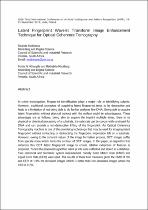 ResearchSpace
ResearchSpace
Latent fingerprint wavelet transform image enhancement technique for optical coherence tomography
JavaScript is disabled for your browser. Some features of this site may not work without it.
- ResearchSpace
- →
- Research Publications/Outputs
- →
- Conference Publications
- →
- View Item
| dc.contributor.author |
Makinana, S

|
|
| dc.contributor.author |
Khanyile, PN

|
|
| dc.contributor.author |
Khutlang, Rethabile

|
|
| dc.date.accessioned | 2017-02-23T09:59:39Z | |
| dc.date.available | 2017-02-23T09:59:39Z | |
| dc.date.issued | 2016-09 | |
| dc.identifier.citation | Makinana, S., Khanyile, P.N. and Khutlang, R. 2016. Latent fingerprint wavelet transform image enhancement technique for optical coherence tomography. In: 2016 Third International Conference on Artificial Intelligence and Pattern Recognition (AIPR), 19-21 September 2016, Lodz, Poland | en_US |
| dc.identifier.isbn | 978-1-4673-9187-0 | |
| dc.identifier.uri | http://ieeexplore.ieee.org/document/7585203/ | |
| dc.identifier.uri | http://hdl.handle.net/10204/8947 | |
| dc.description | 2016 Third International Conference on Artificial Intelligence and Pattern Recognition (AIPR), 19-21 September 2016, Lodz, Poland. Due to copyright restrictions, the attached PDF file only contains the abstract of the full text item. For access to the full text item, please consult the publisher's website | en_US |
| dc.description.abstract | In crime investigation, fingerprint identification plays a major role in identifying culprits. However, traditional procedure of acquiring latent fingerprint tends to be destructive and leads to a limitation of not being able to do further analyses like DNA. Being able to acquire latent fingerprints without physical contact with the surface could be advantageous. These advantages are as follows; being able to acquire the imprint multiple times, there is no physical or chemical processing of a substrate, the substrate can be concurrently analysed for DNA and can provide a non-destructive lifting of the fingerprint. An Optical Coherence Tomography machine is one of the promising technology that may be used for imaging latent fingerprint without contacting or destructing the fingerprint impression left on a substrate. However, owing to the coherent nature of the image formation process, OCT images suffer from speckle noise which limits the contrast of OCT images. In this paper, an algorithm that enhances this OCT latent fingerprint image to ensure reliable extraction of features is proposed. To test the proposed algorithm latent prints were collected and stored as a database. Two statistical and biometric system measurement namely False Match Rate (FMR) and Equal Error Rate (EER) were used. The results of these two measures gives the FMR of 3% and EER of 1.9% for denoised images which is better than non-denoised images where the EER is 8.7%. | en_US |
| dc.language.iso | en | en_US |
| dc.publisher | IEEE Xplore | en_US |
| dc.relation.ispartofseries | Wokflow;17768 | |
| dc.subject | Forensic investigations | en_US |
| dc.subject | Latent fingerprints | en_US |
| dc.subject | Optical coherence tomography | en_US |
| dc.subject | OCT | en_US |
| dc.subject | Enhancement | en_US |
| dc.title | Latent fingerprint wavelet transform image enhancement technique for optical coherence tomography | en_US |
| dc.type | Conference Presentation | en_US |
| dc.identifier.apacitation | Makinana, S., Khanyile, P., & Khutlang, R. (2016). Latent fingerprint wavelet transform image enhancement technique for optical coherence tomography. IEEE Xplore. http://hdl.handle.net/10204/8947 | en_ZA |
| dc.identifier.chicagocitation | Makinana, S, PN Khanyile, and Rethabile Khutlang. "Latent fingerprint wavelet transform image enhancement technique for optical coherence tomography." (2016): http://hdl.handle.net/10204/8947 | en_ZA |
| dc.identifier.vancouvercitation | Makinana S, Khanyile P, Khutlang R, Latent fingerprint wavelet transform image enhancement technique for optical coherence tomography; IEEE Xplore; 2016. http://hdl.handle.net/10204/8947 . | en_ZA |
| dc.identifier.ris | TY - Conference Presentation AU - Makinana, S AU - Khanyile, PN AU - Khutlang, Rethabile AB - In crime investigation, fingerprint identification plays a major role in identifying culprits. However, traditional procedure of acquiring latent fingerprint tends to be destructive and leads to a limitation of not being able to do further analyses like DNA. Being able to acquire latent fingerprints without physical contact with the surface could be advantageous. These advantages are as follows; being able to acquire the imprint multiple times, there is no physical or chemical processing of a substrate, the substrate can be concurrently analysed for DNA and can provide a non-destructive lifting of the fingerprint. An Optical Coherence Tomography machine is one of the promising technology that may be used for imaging latent fingerprint without contacting or destructing the fingerprint impression left on a substrate. However, owing to the coherent nature of the image formation process, OCT images suffer from speckle noise which limits the contrast of OCT images. In this paper, an algorithm that enhances this OCT latent fingerprint image to ensure reliable extraction of features is proposed. To test the proposed algorithm latent prints were collected and stored as a database. Two statistical and biometric system measurement namely False Match Rate (FMR) and Equal Error Rate (EER) were used. The results of these two measures gives the FMR of 3% and EER of 1.9% for denoised images which is better than non-denoised images where the EER is 8.7%. DA - 2016-09 DB - ResearchSpace DP - CSIR KW - Forensic investigations KW - Latent fingerprints KW - Optical coherence tomography KW - OCT KW - Enhancement LK - https://researchspace.csir.co.za PY - 2016 SM - 978-1-4673-9187-0 T1 - Latent fingerprint wavelet transform image enhancement technique for optical coherence tomography TI - Latent fingerprint wavelet transform image enhancement technique for optical coherence tomography UR - http://hdl.handle.net/10204/8947 ER - | en_ZA |





